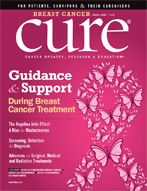Publication
Article
CURE
Positive Energy: Preventing Local Recurrence of Breast Cancer With Radiation
Author(s):
Radiation therapy after surgery can help prevent the local recurrence of breast cancer, and new methods are allowing doctors to tailor the technique to meet the needs of individual patients.
Leslie Husain knows a thing or two about radiation.
The 52-year-old wife and mother of two spent years working as a radiology technologist, performing mammograms on countless women. Four years ago, after having her own routine mammogram at the very hospital at which she used to work, she got some unexpected news — there was something in her left breast. An ultrasound soon confirmed it: Husain had a tumor that measured about 8 millimeters, right below her nipple.
A few weeks later, on July 8, 2011, Husain underwent a lumpectomy. During the surgery, she says, doctors were able to confirm through a tracer procedure — which identifies lymph nodes that drain from the affected area of the breast — that her sentinel node was clear (meaning the cancer had a very low chance of spreading to other lymph nodes). That was welcome news, since it meant she did not need to undergo an axillary dissection, more extensive surgery that carries a higher risk of lymphedema, permanent swelling of the arm.
Because her tumor was small and found early, and because her cancer was confined to the breast, Husain did not need to undergo chemotherapy, drugs that are typically given through the bloodstream to treat invasive cancers or cancers that have advanced into other areas of the body. Husain says that only 3 millimeters of her tumor was invasive, with ductal carcinoma in situ (DCIS), or stage 0 cancer, surrounding the invasive part.
Her doctors determined that radiation therapy was appropriate to help prevent a recurrence in the breast and, together, they began to talk about options.
“My radiation oncologist told me about a Canadian study of the hypofractionated approach,” she says. Hypofractionation (sometimes called accelerated breast irradiation) treats patients with a slightly larger dose of daily radiation over a shorter duration of time. “Cutting the treatment time down from six weeks to four sounded good to me,” Husain says.
But after her first surgery, doctors realized she still had one microscopic spot of DCIS on one “little spot of margin,” she says. Her radiation oncologist wanted the margins clear before radiation therapy began, so she had a re-excision surgery on July 20. In August 2011, Husain began her hypofractionated radiation treatments — just after dropping her daughter off to begin her junior year of college, and as her son began his freshman year — and finished them three to four weeks later. Today, because her tumor was estrogen receptor-positive, she continues to take tamoxifen, a hormonal therapy designed to block the effects of estrogen and reduce the risk of cancer recurrence.
“Almost all patients who have local surgery [lumpectomy] benefit from having radiation,” says Jaroslaw T. Hepel, director of the stereotactic radiotherapy and radiosurgery program at Rhode Island Hospital and assistant professor of radiation oncology at the Warren Alpert Medical School of Brown University. When a lumpectomy is performed, he explains, microscopic cancer cells can be left behind. Radiation reduces the chance of local recurrence of the cancer by destroying those microscopic cells.
Catherine Park, chair of the Department of Radiation Oncology at the University of California San Francisco and professor in residence in radiation oncology, says that, after surgery, radiation has a larger impact than systemic therapies do in reducing the local recurrence of cancer.
“Radiation reduces risk of local recurrence by about two-thirds,” she says, adding that most of her patients receive whole-breast external beam radiation.
The absolute benefit depends on risk factors, and can vary from 2 to 20 percent.
Understanding Radiation
Simply put, radiation is a type of energy used to destroy cancer cells. Radiation therapy (sometimes called “radiotherapy”), often used in treating breast cancer, can be given on its own or in conjunction with medical therapies, such as chemotherapy and hormonal therapy. Radiation therapy is usually given after surgery, and can be delivered in several different ways.
The most common is called external beam radiation, during which a machine outside the body focuses high-energy beams on the breast that is affected by cancer. If it follows breast-conserving surgery, rather than mastectomy, it most often targets the whole breast; it may also target lymph nodes, if cancer was found there. Typically, external beam radiation is given five days a week for six or seven weeks, after the person has healed from surgery or finished chemotherapy (if chemotherapy was part of the treatment plan). This treatment time includes a special radiation “boost” near the end of the therapy cycle, which consists of radiation at a somewhat higher dose than previously given, targeted directly at the area where the tumor was.
Radiation can also be given internally, which means that the radiation source is placed inside the body. This is sometimes called partial breast irradiation or brachytherapy. The radiation source can be inserted in a few different ways, and treatment is concentrated more directly on the affected area of the body than it is in whole breast radiation.
Brachytherapy may be administered through catheters in the breast into which radioactive “seeds” or pellets are placed for a short time and then removed. While the radiation source is in place for just a specified number of minutes, the catheters remain in place for a week or so, with treatment administered twice a day. Brachytherapy may also be administered through a procedure known as balloon-catheter internal radiation, during which a balloon-like structure is placed into the body at the site where the tumor was. Radioactive “seeds” are then placed into the structure for a short amount of treatment time. When the full multi-day course of treatment (typically 10 treatments over five days) is completed, the structure is removed.
The length of treatment is typically shorter with brachytherapy than with external beam radiation; however, there haven’t been many studies that have done head-to-head comparisons of patient outcomes using internal radiation treatments versus external beam radiation, so experts aren’t certain that the long-term benefits of brachytherapy can match those achieved via external beam radiation. Phase 3 studies comparing standard radiation to partial breast irradiation have been completed in the U.S. and Canada, but the results are not yet available.
Radiation therapy often follows surgery in patients who have breast cancer in stages 1 through 3, but may not be needed in women older than 70 with stage 1 disease that has not spread to the lymph nodes and has been treated with surgery and hormonal therapy, according to the American Cancer Society (ACS).
Advancing Techniques
Side effects of radiation therapy for breast cancer may include fatigue, loss of appetite and skin changes such as redness, itchiness, soreness, blistering and peeling. Other side effects may include the irradiated breast shrinking and becoming firmer; infection; lymphedema, if axillary lymph nodes have been treated; rarely, nerve damage in the arm, known as brachial plexopathy, resulting in numbness, weakness and pain; and weakened ribs that can be prone to fracture, according to the ACS. Very rarely, and depending on where the tumor is located, radiation therapy can impact the heart and lungs, and another very rare potential complication is the development of a softtissue cancer, or sarcoma, in the radiated area, most often angiosarcoma.
Husain experienced some skin-related side effects. “My skin was red where the radiation was and then completely white where it wasn’t,” she says. “The line was so sharp.” One of the biggest lasting impacts, she adds, was having to be careful about exposing her radiated breast to the sun.
Some patients are fearful of receiving radiation therapy, particularly those who have friends or family members who’ve had radiation for other types of cancer that are treated differently than breast cancer is treated.
“Radiation is quite safe, and our techniques are advanced,” Park says. “Many of the advancements we’ve seen are really in risk assessment, particularly as we move toward understanding the biology of the disease.”
While Hepel acknowledges that side effects can be uncomfortable for patients, he emphasizes how far breast cancer treatment has come. “We are so much better at treating and curing this disease than we were five years ago,” he says.
At Rhode Island Hospital, for patients who are appropriate candidates, Hepel’s team now uses a radiation therapy called non-invasive image-guided breast brachytherapy. According to Hepel, this treatment method is similar to a mammogram in that it compresses the breast gently (though it doesn’t use nearly the compression strength of a mammogram) and makes an image.
“We can see where the surgery was done,” he says. “Then, a special brachytherapy applicator that is attached to the compression plates uses a localized external beam (to treat the site).”
This method is in use at about 50 centers around the United States to deliver the “boost” that comes at the end of external beam radiation therapy, but it is also being used experimentally as a standalone treatment for some patients. Rhode Island Hospital began using this protocol about four or five years ago, and patients have tolerated it well, he says, adding that candidates for this treatment option typically have tumors less than 2 centimeters in size with no aggressive features or invasion of the lymph nodes.
Hepel says he’s now seeing many new techniques that allow radiation oncologists to tailor the radiation treatment to the patient in terms of stage of disease and individual anatomy. For example, part of the treatment planning process might include a CT scan that clearly shows a patient’s particular anatomy, or intensity-modulated radiation therapy (IMRT), which creates an infrared map of the outer contours of a tumor. These images are useful in planning treatment for a patient whose heart sits right under the breast being treated, and allows radiation oncologists to use different techniques and maneuvers to mitigate risk to the heart. One such technique, Hepel says, is prone treatment, during which the patient lays on her stomach on a “breast board” that allows the breasts to hang down through cut-outs. “This position separates the breasts from the chest wall and makes the heart less of an issue in radiation treatment,” he says.
When it comes to choosing treatment type, it’s important to know that sometimes there may be a choice of approaches, but sometimes there is only one choice, Hepel notes. “Each has its place, but they are not interchangeable options.”
These treatments are a good example of the “horizons where we’re trying to head,” Hepel concludes. “We want to decrease the impact of therapies both during and after the treatment. This starts with identifying patients by better understanding the biology of the cancer. The patient is always an active participant. We want to educate them about their disease.”
Husain is on the same page. Now that she’s completed her radiation therapy and is on a maintenance regimen, she wants to help other women with cancer to understand their treatment options.
She’s giving back by volunteering with SHARE, a breast cancer and ovarian cancer helpline that provides participants with the opportunity to receive and exchange information and support — including what those who receive radiation treatments can expect to see and feel.





